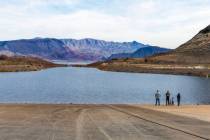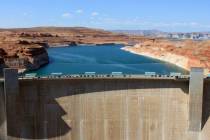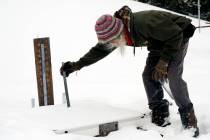The National Park Service has recovered the bodies of two missing boaters at Lake Mead National Recreation Area.
Lake Mead
The National Park Service is searching for two missing boaters at Lake Mead National Recreation Area.
The Las Vegas Valley Water District said it conducted 320,000 analyses on more than 55,000 water samples from Lake Mead and other storage reservoirs.
The three Lower Basin states collectively used the least amount of water since 1983, according to a Bureau of Reclamation report.
Resorts made up 80 percent of the top 50 commercial water users in the Las Vegas Valley Water District in 2023. How much of that returns to Lake Mead?
The Department of Interior announced a $700 million investment in water conservation projects in the Lower Colorado River Basin.
Five-year projections, which the Bureau of Reclamation releases three times a year, are showing that snowpack may have boosted Lake Mead.
People gather at Lake Mead over Memorial Day weekend.
Park rangers and officials from Lake Mead, Death Valley, Grand Canyon and other national parks held a roundtable about keeping summer vacations fun and safe.
Safety while boating at Lake Mead National Recreation Area has long been an issue, leading to several deaths almost every year since 2000.
Nevada lawmakers signed onto a letter with more than 30 other members of Congress on Monday, calling for more federal funds to help address drought in the West, which is only expected to intensify.
Multiple government bodies are attacking the problem of forever chemicals head on, especially with new regulations handed down from the Environmental Protection Agency.
Federal officials recently reported damage to four tubes known as “river outlet works” at Glen Canyon Dam on the Utah-Arizona border.
Snowpack numbers for the Rocky Mountains are above the median, but whether that will translate to better water levels for Lake Mead and Nevada is unclear.
Tubes at Glen Canyon Dam might be damaged, threatening future deliveries from Lake Powell if water levels get too low, the Bureau of Reclamation said.

















